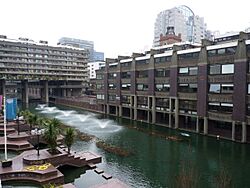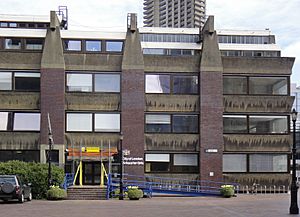City of London School for Girls facts for kids
Quick facts for kids City of London School for Girls |
|
|---|---|
 |
|

The School, seen on the right, facing the waterway and fountains of the Barbican Centre
|
|
| Location | |
|
Barbican
London, EC2 United Kingdom
|
|
| Coordinates | 51°31′09″N 00°05′40″W / 51.51917°N 0.09444°W |
| Information | |
| Type | Private day school |
| Motto | Latin: Domine Dirige Nos (O Lord Direct us) |
| Established | 1894 |
| Founder | William Ward |
| Local authority | City of London |
| Department for Education URN | 100001 Tables |
| Headmistress | Jenny Brown |
| Gender | Girls |
| Age | 7 to 18 |
| Enrolment | 707 |
| Houses | Fleet, Tudor, St. Bride & Ward |
| Colour(s) | Red |
| Alumnae | City of London Old Girls |
| Website | http://www.clsg.org.uk |
The City of London School for Girls (CLSG) is a private school for girls. It is located next to the Barbican Centre in the City of London. This school is a partner to the all-boys City of London School. It also partners with the City of London Freemen's School. All three schools get money from the City of London's funds. CLSG is a member of important school groups like the Headmasters' and Headmistresses' Conference (HMC). It is also part of the Girls' Schools Association.
Contents
A Look at the School's History
The City of London School for Girls started because of a gift from William Ward. He was a merchant from Brixton. In 1881, he decided that girls should have a good education. He wanted them to learn many subjects and become smart. So, he left a large part of his money to the City of London. This money was used to open the girls' school.
The school first opened its doors in Carmelite Street in 1894. The Corporation of London still manages the school today. A group of governors, chosen by the Court of Common Council, helps run it. The school also gets money from other groups in the City. These include old trade groups called Livery Companies and banks. In 1969, the school moved to its current buildings. These are located in the Barbican Estate.
What the School is Like
The school is known for its strong academic results. In 2018, The Sunday Times newspaper said it was the second-best independent school in the UK. This was based on how well students did in their GCSE and A-Level exams. The school has also had students who joined the UK International Mathematical Olympiad teams.
The Good Schools Guide describes the school as having a mix of students and teachers. This mix reflects its location in the heart of the city. The school used to have a small junior school. However, this became part of the new City Junior School in 2022. Some students also join the school when they are 16 years old.
The school has fees, which are currently about £7,926 per term. This does not include school lunches. Students get into the school by taking an exam. About 25% of students get financial help. This help can include full bursaries, which means they don't have to pay fees.
The school does not belong to any one religion. However, it has some Christian traditions. For example, there is an optional Carol Service each year. This service takes place in the nearby St Giles' Church. The school also has different societies for students. These include a Jewish Society, an Asian Society, and an African-Caribbean Society.
The school uses a house system. There are four houses: Fleet, Tudor, St. Bride, and Ward. These names come from local streets and the school's founder, William Ward. Students compete in many inter-house events. These include Drama, Debating, Maths, Art, and Music. There are also sports competitions throughout the year.
The school has had 12 headmistresses since it opened. Jenny Brown is the current headmistress. She took on the role in 2019.
Fun Activities and Clubs
The school is very close to the Barbican Arts Centre. It is also near the Guildhall School of Music and Drama. Because of this, the school focuses a lot on the arts. Students can even get music scholarships with the Guildhall Music School. Since 2005, the school has held a drama festival called Moat Fest.
The school has many great facilities. These include a swimming pool and a lecture theatre. There are also two netball and tennis courts. Students can use a drama studio and an all-weather playing field. There is an indoor gym with a climbing wall. Another gym has exercise equipment like treadmills and weights. The school has won the national European Youth Parliament competition several times. It also has a strong debating program.
The school offers language exchange trips to countries like France, Spain, Germany, and China. Students also have other chances to travel. For example, through the World Challenge program, girls have visited places like Venezuela. Duke of Edinburgh Award expeditions have taken place only in the UK since 2001. This change was made to ensure student safety during these outdoor adventures. The school also hosts exchange students from other countries. These include Australia, China, Germany, France, and Spain.
The City of London School for Girls is the only school to have won the international Kids' Lit Quiz twice. They won in 2010 and again in 2014.
School Buildings
The school is in a Grade II listed building. This means it is a special building with historical importance. It is located within the Barbican area.
The school has had some discussions about expanding its buildings. In 2018, there were plans to expand the junior school. These plans involved using an underground car park. However, these ideas faced strong local opposition. Another expansion plan was also proposed but was later stopped.
Headmistresses of the School
- 1894–1910 Alice Blagrave
- 1910–1927 Ethel Strudwick
- 1927–1932 Hilda Doris Bugby
- 1932–1937 Julia Elizabeth Turner
- 1937–1949 E. D. M. Winters
- 1949–1972 Gladys Colton
- 1972–1986 Lily M. Mackie
- 1986–1995 Lady Valerie France
- 1995–2007 Yvonne Burne
- 2007–2014 Diana Vernon
- 2014–2019 Ena Harrop
- 2019–present Jenny Brown
Notable Former Students
Many successful women have attended the City of London School for Girls. Here are a few:
- Wilhelmina Hay Abbott, a supporter of women's right to vote
- Dido Armstrong, a famous singer
- Margaret Boden, a scientist
- Fiona Caldicott, a psychiatrist
- Hilary Cass, a leader in child health
- Daisy Christodoulou, an expert in education
- Jean Dawnay, a fashion model
- Elizabeth Emanuel, a fashion designer
- Romola Garai, an actress
- Grace Golden, an artist
- Sarah B Hart, a mathematician
- Sahar Hashemi, an entrepreneur
- Tin-Tin Ho, a table tennis player
- Hermione Lee, a professor of English
- Megan Lloyd George, a politician
- Tasmin Lucia Khan, a news presenter
- Georgina Mace, a conservation scientist
- Mary Nighy, an actress
- Ella Purnell, an actress
- Claire Rayner, a journalist
- Dinah Rose, a lawyer
- Dorothy Spiers, the first female actuary in the UK
- Margaret Stacey, a sociologist
- Olivia Sudjic, a novelist
- Margaret Turner-Warwick, the first female president of the Royal College of Physicians
- Alison Weir, a historian and writer
- Claudia Winkleman, a television presenter
- Sophie Winkleman, an actress


